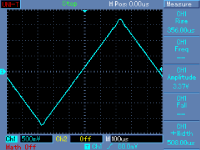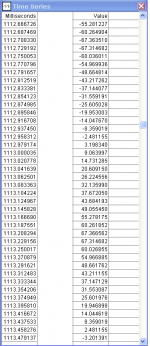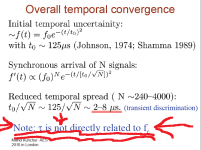The best DAC I've ever heard uses a first order 22kHz filter.
John
John, you have 20-22kHz brickwall filter during A/D - recording process, and this inevitable for red book CD.
Regards,
Applying this line of reasoning to the size of people, we should have 5 meter tall giants.
That´s the basis of statistical reasoning; take one or more representative groups of samples, construct a statistic from the data for the whole population.
If a small sample leads to the conclusion that 5 meter tall giants might probably exist, than it is precisely what to get from the data (under the assumption of mathematical correctness).
If other reliable data contradicts your conclusion from the data basis, well then you know at least that you are in trouble.
But data for height of people is sampled in big numbers for a long time while data for psychoacoustics is normally taken from small groups with often unknown representative status.
Temporal resolution works on the basis of phase shifts. As you may know, < 3.500 Hz or so, the nerve fibers connected to you inner ear fire at a precise point of the incoming signal, that is, they are phase locked. Hence, with for example a 1000 Hz tone (1mS wide), the temporal resolution may be < 10uS.
Therefore, you can't argue that, since the temporal resolution is < 10uS, we need >100KHz bandwith. They are not related. As a matter of fact, for higher frequencies, where the nerve fibres are no longer phase locked, the concept of temporal resolution looses its validity.
vac
As rsdio already said, if we could enhance the temporal resolution (monoaural) without raising the upper frequency bound, it might be already sufficient, but normally we couldn´t.
@ rsdio,
unsufficient antialias filtering is an additional problem (the transition band from 20kHz to 24kHz is already not such a good idea, so one should not try to get higher in frequency for a 44.1kHz sample rate).
@ SY,
the point is that testing with socalled illegal signals (that couldn´t exist without violation of nyquist) does make sense as such could appear during replay of cd content, if nobody ensures during digital audio work that `illegal` will not exist.
PMA can you give me the 'recording level' of the triangle wave that you recently showed?
Sorry if I should have missed something.
I showed 3 triangle waves, so I will try not to confuse the issue. In the D/A - A/D linearity test, the full scale of the A/D converter was +100%/-100% and triangle wave was +67%/-67%. The investigated portion (linearity measurement) took +15%/-15%.
The triangle that I have shown later was the D/A output captured by scope. You can read the Vp-p from the image, I am posting it again.
Attachments
P/Ns
Thanks for the reminder that just because you learn something doesn't mean it is there when you look for it...
Thanks for the fun! Howie
Howard Hoyt
CE - WXYC-FM
UNC Chapel Hill, NC
www.wxyc.org
1st on the internet
Oh duh...memory fart..been a while since I messed with tube equipment other than broadcast transmitters.ECC83 aka 12AX7 A bit of a common audio tube.
Another duh! I remember making a power amp with a couple of those (or were then 2N109s?) and a 2N301, the 1st TO-3 transistor I ever used.2N107 GE's killer app germanium transistor
Got me on that one.Ua703 Fairchild's IF amplifier chip
Now I feel even more stupid than usual: I made an iambic keyer using those when I first became a ham in 1970.Ul923 Fairchild's RTL Flip Flop Probably the first widely used logic family.
Thanks for the reminder that just because you learn something doesn't mean it is there when you look for it...
Thanks for the fun! Howie
Howard Hoyt
CE - WXYC-FM
UNC Chapel Hill, NC
www.wxyc.org
1st on the internet
Hi,
Maybe not. Both AES and ASA tend to be suspiciously US focused and dominated.
What about the cheese heads and the fact that there is virtually no consumer audio design in the US at all. The AES convention that I attended was very Eurocentric.
The mini-disk was introduced as the new perfect sound and even I winced at the sound it made.
Just for everyone's information, an aquaintance of mine Rob Danielson a retired professor at UWM who taught sound recording for film has gone over much of this ground solely judging on how it sounds and has most of his tests in a public archive.
https://pantherfile.uwm.edu/type/www/audio-art-tech-gallery/
There is a LOT here. He is not an engineer and some still will not like what he says.
https://pantherfile.uwm.edu/type/www/audio-art-tech-gallery/
There is a LOT here. He is not an engineer and some still will not like what he says.
Last edited:
Where do these signals come from in actual recordings? Are you aware of any studios that don't use antialiasing filters?the point is that testing with socalled illegal signals (that couldn´t exist without violation of nyquist) does make sense as such could appear during replay of cd content, if nobody ensures during digital audio work that `illegal` will not exist.
biological variations don't necessarily (or even often) result in smooth, symmetric, "infinite tail" distributions
assuming Gaussian distribution may be the "default" for some "canned" statistics packages but that doesn't make it predictive of real world data distributions
My objection is the that some want to "assume their conclusions" as a method of argument, "proof"
to me the data in peer reviewed papers is not yet conclusive, 44.1 kHz is not "obviously" inadequate for Music reproduction
many accepted measurements, detailed models for human auditory perception, even typical recording, playback equipement limits make it plausible that content above 20 kHz isn't of 1st order importance
small "time difference" resolution numbers, IATD, keep getting misinterpreted as implying channel bandwidth of ~ 1/dt - this has been pointed out as logically wrong many times now
see Kunchur's slide: (my Paint underlines, arrows)
assuming Gaussian distribution may be the "default" for some "canned" statistics packages but that doesn't make it predictive of real world data distributions
My objection is the that some want to "assume their conclusions" as a method of argument, "proof"
to me the data in peer reviewed papers is not yet conclusive, 44.1 kHz is not "obviously" inadequate for Music reproduction
many accepted measurements, detailed models for human auditory perception, even typical recording, playback equipement limits make it plausible that content above 20 kHz isn't of 1st order importance
small "time difference" resolution numbers, IATD, keep getting misinterpreted as implying channel bandwidth of ~ 1/dt - this has been pointed out as logically wrong many times now
see Kunchur's slide: (my Paint underlines, arrows)
Attachments
Last edited:
Yes, RF carriers are meant to be demodulated. Scaling these effects directly to audio is a stretch, but you are welcome to.
Did you get to the part about micro diodes?
I have a problem with calling all non-ohmic response evidence of diode action. The coherers mentioned before seems to rely on slightly polar to polar molecular alignment changing conductivity. I see that as different than a semiconductor junction, where there is no molecular movement required.
Did you get to the part about micro diodes?
I have a problem with calling all non-ohmic response evidence of diode action. The coherers mentioned before seems to rely on slightly polar to polar molecular alignment changing conductivity. I see that as different than a semiconductor junction, where there is no molecular movement required.
Missed that, the rate of change of the fields here are rather high and think about RF burns. Hard to do that with a preamp output.
Missed that, the rate of change of the fields here are rather high and think about RF burns. Hard to do that with a preamp output.
Actually cell site transmitters as things go are quite small so they don't go over range. The receive levels can be just above the noise level. A receive level can be 1exp-9 watts and a transmit level 25 watts or 104 db dynamic range. A 17 bit converter would work!
So there might actually be some applicability!
I would again like to comment about the 'essence' of quality audio. We appear to be making progress in digital 'compromises' thanks to T and PMA, which might be the making of a technical paper in future by somebody. It is important to be able to tell the difference between specs. and performance. Sometimes, specs. can be misleading.
Let me give a parallel example:
Almost 60 years ago, I got a Tasco (Japanese) 60mm refractor telescope for Christmas. I was overjoyed, because at the time, I had hoped to be an astronomer (I still sometimes wish I had gone in that direction). Of course, this small telescope had limitations, BUT not as many as you would think. I saw the normal stuff, but sometimes, with a little effort, I could resolve what I was told that a scope this size could not resolve. It is no secret, in retrospect, why. This little scope was well made, perhaps by people who made military optics during WW2. In any case, it really worked to the extent of its specifications and it gave me years of enjoyment. Had it not been stolen, perhaps 5 years later, I would have continued to use it, until something bigger and better became affordable.
Well, years later, I decided to buy another Tasco telescope, much like the one I lost. I found one, seemed to work, BUT it just was not the same quality, YET it had the same optical specifications. I tried several Tasco telescopes, over the years, and settled with a slightly bigger one, 90mm, and it's a 'dog' too! Why? I should have had an optical advantage with the somewhat larger scope. Well, specs. are specs. and user quality is above and beyond the specs. It is the same with audio. A well maintained Dyna Stereo 70, coupled to the right speakers can operate beyond its 'specifications' in sound quality, I have heard it, myself, with another audio professional's systems. Of course, you have to work within its limitations, but with a pair of LS3-5A's it was awesome! Yet, I make amps with up to 20 times more power, almost effortlessly, but I would not have chosen a JC-1 pair of amps in this set-up. Of course, the guy's wife worked full time for Reference Recordings, etc., etc. so they had confidence in their trade-offs, and pulled it off! Enough for now.
Let me give a parallel example:
Almost 60 years ago, I got a Tasco (Japanese) 60mm refractor telescope for Christmas. I was overjoyed, because at the time, I had hoped to be an astronomer (I still sometimes wish I had gone in that direction). Of course, this small telescope had limitations, BUT not as many as you would think. I saw the normal stuff, but sometimes, with a little effort, I could resolve what I was told that a scope this size could not resolve. It is no secret, in retrospect, why. This little scope was well made, perhaps by people who made military optics during WW2. In any case, it really worked to the extent of its specifications and it gave me years of enjoyment. Had it not been stolen, perhaps 5 years later, I would have continued to use it, until something bigger and better became affordable.
Well, years later, I decided to buy another Tasco telescope, much like the one I lost. I found one, seemed to work, BUT it just was not the same quality, YET it had the same optical specifications. I tried several Tasco telescopes, over the years, and settled with a slightly bigger one, 90mm, and it's a 'dog' too! Why? I should have had an optical advantage with the somewhat larger scope. Well, specs. are specs. and user quality is above and beyond the specs. It is the same with audio. A well maintained Dyna Stereo 70, coupled to the right speakers can operate beyond its 'specifications' in sound quality, I have heard it, myself, with another audio professional's systems. Of course, you have to work within its limitations, but with a pair of LS3-5A's it was awesome! Yet, I make amps with up to 20 times more power, almost effortlessly, but I would not have chosen a JC-1 pair of amps in this set-up. Of course, the guy's wife worked full time for Reference Recordings, etc., etc. so they had confidence in their trade-offs, and pulled it off! Enough for now.
Almost 60 years ago, I got a Tasco (Japanese) 60mm refractor telescope for Christmas. .
Wow, me too! The objective was not that good actually.
Gee, John, was that a 1st-order filter with a corner frequency of 22 kHz? That would mean it is only down 3 dB at 22 kHz, and vastly insufficient for the requirements. A great deal of frequencies above the corner frequency are allowed through the transition band and stop band of a 1st-order low-pass.The best DAC I've ever heard uses a first order 22kHz filter.
I'm not saying that a 1st-order filter wouldn't work, I'm merely stating that it's corner frequency would have to be sufficiently below 22 kHz in order to suppress a reasonable amount of the aliasing. I'd say that a low-pass at about 1 Hz, or maybe at low as 0.33 Hz, should be sufficient to bring 22 kHz down more than 90 dB (assuming 16-bit DAC). That really wouldn't leave much in the audio band, but it should remove the aliasing.
Sorry for the sarcasm, but if vinyl is such a great recording medium, then why didn't they just convert the track from the LP after they couldn't find the Nagra tape? I've certainly purchased many modern CDs where the track shows obvious rumble and surface noise because they didn't go back to pre-vinyl masters.I have a folk LP from 1965 where one cut sounded far better than all the rest, when the CD came out in 1999 that cut was missing. Upon inquiry it turns out that cut was an audience tape made on a Nagra and was lost.
SY, I believe that Jakob is referring to digital processing during mixing and/or mastering, not merely the A/D process. Even assuming proper A/D resulting in kosher original recordings, there are many digital effects, including modeling of analog effects, that can create frequency modulation components that are not 'legal' in the data stream. This can be partially reduced by digital oversampling followed by digital anti-alias filtering, but sometimes the processing power is not there, the programming chops are not sufficient, or it simply becomes difficult to mathematically predict the highest sample rate to completely avoid frequency artifacts above Nyquist. One example is fast changes to the gain, such as during dynamics processing, which create modulation components.Where do these signals come from in actual recordings? Are you aware of any studios that don't use antialiasing filters?
- Status
- Not open for further replies.
- Home
- Member Areas
- The Lounge
- John Curl's Blowtorch preamplifier part II


